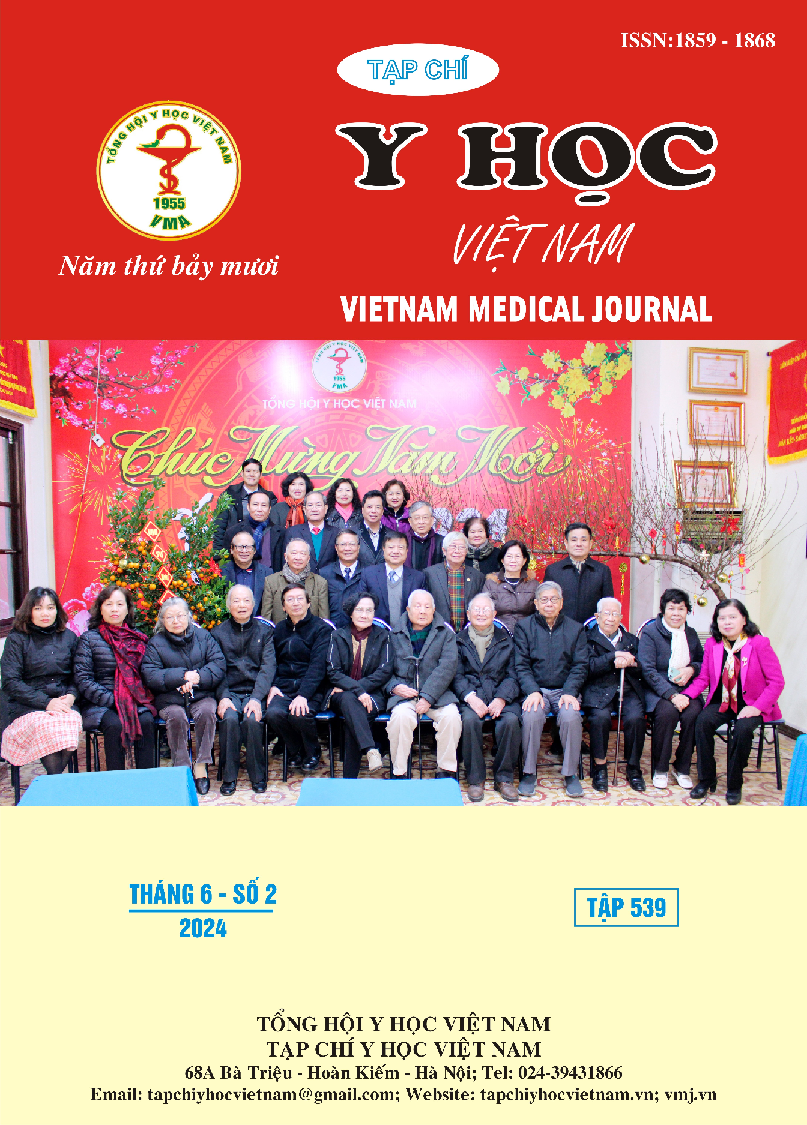ASSESSMENT OF FACTORS ASSOCIATED WITH NEUROPATHIC PAIN BY USING THE LANSS SCALE IN PATIENTS WITH SPONDYLOLISTHESIS AT BACH MAI HOSPITAL
Main Article Content
Abstract
Objective: To assess factors related to neuropathic pain in patients with lumbar disc degenerative disease. Study Subjects: Conducted a study on 102 patients diagnosed with spondylolisthesis (degenerative vertebral column) experiencing spine pain with a Visual Analog Scale (VAS) score ≥ 3, treated at the Centre for Rheumatology from October 2022 to October 2023. Research Method: Cross-sectional descriptive analysis. Results: There was a correlation between neuropathic pain, assessed by LANSS and factors: age, the risk was 5.18 times higher in the age group ≥ 70. Overweight and obese patients (BMI ≥ 23) had a 5.02 times higher risk of neuropathic pain. The group with a history of lumbar spine surgery had a 2.95 times higher risk of neuropathic pain. The high pain intensity group (VAS ≥ 7) had a 6.48 times higher risk of neuropathic pain. The risk of neuropathic pain in the X-ray group with disc space narrowing and foraminal stenosis was higher, with odds ratios of 3.78 and 16.15, respectively. The group with ≥ 4 degenerated lumbar vertebrae had a 6.62 times higher risk of neuropathic pain. There was no statistically significant difference in the risk of neuropathic pain related to gender, duration of lumbar spine pain, X-ray evidence of lumbar lordosis loss, bone spurs, or subchondral sclerosis. Conclusion: The risk of neuropathic pain assessed by LANSS increased in the older age group (≥ 70), overweight/obese individuals, those with a history of lumbar spine surgery, higher pain intensity (VAS ≥ 7), X-ray evidence of disc space narrowing and foraminal stenosis, and a greater number of degenerated lumbar vertebrae (≥ 4), with odds ratios of 5.18, 5.02, 2.95, 6.48, 3.78, 16.15, and 6.62.
Article Details
Keywords
spondylolisthesis, degenerative vertebral column, neuropathic pain, LANSS.
References
2. Bennett MI, Smith BH, Torrance N, Potter J. The S-LANSS score for identifying pain of predominantly neuropathic origin: validation for use in clinical and postal research. The journal of pain. 2005;6(3):149-158.
3. El Sissi W, Arnaout A, Chaarani MW, et al. Prevalence of neuropathic pain among patients with chronic low-back pain in the Arabian Gulf Region assessed using the leeds assessment of neuropathic symptoms and signs pain scale. The Journal of international medical research. 2010;38(6):2135-2145.
4. Kaki AM, El-Yaski AZ, Youseif E. Identifying neuropathic pain among patients with chronic low-back pain: use of the Leeds Assessment of Neuropathic Symptoms and Signs pain scale. Regional anesthesia and pain medicine. 2005;30(5):422-428.
5. Rajput K, Ng J, Zwolinski N, Chow RM. Pain Management in the Elderly: A Narrative Review. Anesthesiology clinics. 2023;41(3):671-691.
6. Lục Chánh Trực. Đánh giá sự khác biệt giữa đau thần kinh và đau thụ thể mạn tính bằng thang điểm DN4 và LANSS. Tạp chí y học thành phố Hồ Chí Minh. 2016;168-174.
7. Sivas F, Uzun Ö, Başkan B, Bodur H. The neuropathic pain component among patients with chronic low back-radicular pain. Journal of back and musculoskeletal rehabilitation. 2018;31(5):939-946.
8. Ceceli E, Gumruk S, Okumus M, Kocaoglu S, Goksu H, Karagoz A. Comparison of 2 methods of neuropathic pain assessment in carpal tunnel syndrome and hand functions. Neurosciences (Riyadh, Saudi Arabia). 2018;23(1):23-28.


